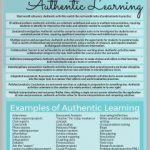13 Authentic Learning Activities and Assessments
Authentic learning is a style of learning that is like real-life learning. Students are encouraged to create real-life, tangible products that use the knowledge and skills acquired to create real-world tangible products and experiences. Integrating authentic learning into your online classroom with activities and assessments not only allows students to use the knowledge and skills you have taught, but it also allows them to create products that are meaningful to their learning, their career, and the community.
The 10 Design Elements of Authentic Learning:
- Real-world relevance: Authentic activities match the real-world tasks of professionals in practice
- Ill-defined problem: Authentic activities are relatively undefined and open to multiple interpretations, requiring students to identify for themselves the tasks and subtasks needed to complete the major task.
- Sustained investigation: Authentic activities comprise complex tasks to be investigated by students over a sustained period of time, requiring a significant investment of time and intellectual resources.
- Multiple sources and perspectives: Authentic activities provide the opportunity for students to examine tasks from a variety of theoretical and practical perspectives, using a variety of resources, and require students to distinguish relevant from irrelevant information.
- Collaboration: Success is not achievable by an individual learner working alone. Authentic activities make collaboration integral to the task, both within the course and in the real world.
- Reflection (metacognition): Authentic activities enable learners to make choices and reflect on their learning, both individually and as a team or community.
- Interdisciplinary perspective: Authentic activities have consequences that extend beyond a particular discipline, encouraging students to adopt diverse roles and think in interdisciplinary terms.
- Integrated assessment: Assessment is not merely summative in authentic activities but is woven seamlessly into the major task in a manner that reflects real-world evaluation processes.
- Polished products: Conclusions are not merely exercises or substeps in preparation for something else. Authentic activities culminate in the creation of a whole product, valuable in its own right.
- Multiple interpretations and outcomes: Rather than yielding a single correct answer obtained by the application of rules and procedures, authentic activities allow for diverse interpretations and competing solutions.
Examples of Authentic Learning:
|
Interviews |
Document Analysis “Teacher” for a day, module or concept Case studies Podcasts/Vlogs Product reviews Article critiques Concept mapping Graphing data Presentations Design projects Group Projects Models/constructing objects Proposals Scenarios Data Analysis |
Journaling/reflection Wikis and other collaborative writing Group problem solving Blogs Lab work Role-playing Simulations Fieldwork Field trips Research projects Problem-based learning (PBL) Real-world problems (finding solutions) Editorials |
 Download the Authentic Learning Infographic
Download the Authentic Learning Infographic
Infographic adapted from Lombardi, M. M. (2007). Authentic learning for the 21st century: An overview. Educause learning initiative, 1(2007), 1-12. https://library.educause.edu/~/media/files/library/2007/1/eli3009-pdf.pdf
